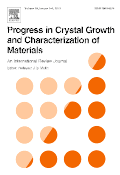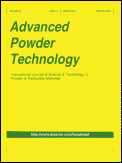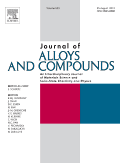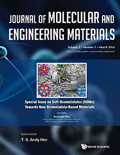
Crystals
metrics 2024
Fostering Collaboration in Multidisciplinary Research
Introduction
Crystals is a premier open-access journal, published by MDPI since 2011, that focuses on the multidisciplinary fields of chemical engineering, condensed matter physics, inorganic chemistry, and materials science. With its E-ISSN 2073-4352, the journal is headquartered in Switzerland, and actively contributes to the global scientific community by facilitating the dissemination of high-quality research. Ranking in the Q2 quartile across multiple categories, including Chemical Engineering (miscellaneous) and Materials Science (miscellaneous) for 2023, Crystals provides a platform for innovative studies that span from fundamental research to practical applications. The journal's commitment to open access ensures that groundbreaking findings are readily available to researchers, professionals, and students alike, fostering an environment of collaboration and knowledge sharing that is essential in advancing the scientific understanding of crystalline materials.
Metrics 2024
 -
- 2.40
2.40 2.40
2.40 -
-Metrics History
Rank 2024
IF (Web Of Science)
JCI (Web Of Science)
Quartile History
Similar Journals

Korean Journal of Materials Research
Connecting Ideas, Inspiring DiscoveriesKorean Journal of Materials Research is a pivotal publication in the field of materials science, offering a platform for innovative research and comprehensive reviews in miscellaneous materials applications. Published by the MATERIALS RESEARCH SOC KOREA, this journal has been a valuable resource since its inception in 2007 and continues to disseminate vital findings through 2024. Although currently categorized in Q4 of the Materials Science quartiles, the journal is committed to advancing knowledge and fostering research collaboration within the scientific community. With an ISSN of 1225-0562 and an E-ISSN of 2287-7258, the journal aims to bridge gaps in research and practice, appealing to a diverse audience of researchers, professionals, and students interested in the latest advancements in materials science. While access to content may not be open, the journal's impact in the regional and global research landscape is steadily growing, as indicated by its Scopus ranking in the 7th percentile of General Materials Science. Engage with the Korean Journal of Materials Research to stay at the forefront of materials innovation!

Inorganic and Nano-Metal Chemistry
Connecting Ideas in Inorganic Chemistry and Nanotechnology.Inorganic and Nano-Metal Chemistry is a premier journal published by Taylor & Francis Inc, focusing on innovative research and advancements in the fields of inorganic chemistry and nano-metal applications. With an increasing impact in the academic community, this journal has established itself within the Q3 category of both Inorganic Chemistry and Physical and Theoretical Chemistry as of 2023, reflecting its global recognition and influence. The journal is accessible as an Open Access publication, ensuring that research findings are freely available to a broad audience, promoting transparency and collaboration in scientific exploration. Based in the United Kingdom, Inorganic and Nano-Metal Chemistry aims to disseminate high-quality peer-reviewed articles that not only highlight fundamental studies but also push the boundaries of technological applications in areas such as catalysis, materials science, and nanotechnology. Researchers, professionals, and students will find this journal an invaluable resource for the latest developments and interdisciplinary insights in the ever-evolving landscape of inorganic and nano-metal chemistry.

Acta Crystallographica Section B-Structural Science Crystal Engineering and Materials
Illuminating the complexities of crystal structures in diverse fields.Acta Crystallographica Section B: Structural Science, Crystal Engineering and Materials, published by the International Union of Crystallography, stands as a pivotal resource for researchers and professionals in the fields of materials science, crystal engineering, and structural biology. With an e-ISSN of 2052-5206, this journal is recognized for its contributions to advancing knowledge on the structural aspects of materials, drawing significant interest from the Q2 category in several disciplines, including Atomic and Molecular Physics and Materials Chemistry. As the field evolves through innovative research approaches and methodologies, the journal actively covers developments within the scope of materials synthesis, characterization, and application in various sectors including medicine and electronics. Though not an open-access journal, it is entangled in the scientific discourse, ensuring that key studies are accessible to academic institutions and professionals globally. With a commitment to excellence, its impact across multiple quartile rankings signifies its influence and importance for scholars eager to contribute to cutting-edge research.

PROGRESS IN CRYSTAL GROWTH AND CHARACTERIZATION OF MATERIALS
Unveiling Innovations in Material CharacterizationPROGRESS IN CRYSTAL GROWTH AND CHARACTERIZATION OF MATERIALS, published by Pergamon-Elsevier Science Ltd, is a premier journal dedicated to the advancement of knowledge in the fields of condensed matter physics and materials science. With an ISSN of 0960-8974 and an E-ISSN of 1878-4208, this esteemed journal has been at the forefront of research since its inception in 1990 and continues to publish cutting-edge findings until 2024. Recognized as Q1 in Condensed Matter Physics and Q2 in Materials Science (miscellaneous) as of 2023, it holds impressive Scopus rankings, placing it in the 89th and 81st percentiles of its respective categories. The journal aims to foster innovation and facilitate the exchange of ideas among researchers and professionals by showcasing significant developments in crystal growth and material characterization methodologies. Although it currently does not offer open access, the journal remains a vital resource for academia, providing comprehensive insights that drive forward the fields of physics and materials science, thereby benefiting both seasoned researchers and students alike.

ADVANCED POWDER TECHNOLOGY
Unleashing Potential in Chemical EngineeringADVANCED POWDER TECHNOLOGY, published by Elsevier, is a premier academic journal dedicated to advancing the field of powder technology and its applications across various domains, such as chemical engineering and materials science. With an ISSN of 0921-8831 and an E-ISSN of 1568-5527, this journal has established itself as a leader in research dissemination, boasting an impressive Q1 ranking in both Chemical Engineering (miscellaneous) and Mechanics of Materials as of 2023. Further enhancing its reputation, it ranks 42nd out of 398 in the field of Mechanics of Materials and 36th out of 273 in General Chemical Engineering, demonstrating its significant impact within these disciplines. With a publishing history spanning from 1990 to 2024, ADVANCED POWDER TECHNOLOGY offers a wealth of knowledge and research findings, positioning itself as an indispensable resource for researchers, professionals, and students eager to explore cutting-edge advancements and applications of powder systems. Access to its latest research is available through institutional subscriptions, ensuring efficiency and support for ongoing academic endeavors.

Physics and Chemistry of Solid State
Innovating the Future of Materials and Condensed Matter PhysicsPhysics and Chemistry of Solid State is a distinguished open access journal published by Vasyl Stefanyk Precarpathian National University in Ukraine, dedicated to advancing research in the fields of condensed matter physics, materials science, and physical and theoretical chemistry. Since its inception in 2000, the journal has provided a platform for the dissemination of innovative ideas and original research findings, contributing significantly to the global scientific community. With a variety of access options, it facilitates the sharing of knowledge and collaboration among researchers worldwide. The journal has garnered recognition with respectable rankings in Scopus, positioning itself among the significant publications in its domain, particularly noted for its contributions to materials science and condensed matter physics. As it moves through its converged years from 2018 to 2024, Physics and Chemistry of Solid State aims to foster interdisciplinary dialogue and prepare the next generation of scientists to tackle complex challenges in solid-state research.

CRYSTENGCOMM
Empowering researchers with groundbreaking discoveries in crystallization.CRYSTENGCOMM is a distinguished journal published by the Royal Society of Chemistry, dedicated to advancing the field of crystallization and crystal engineering. With its impact factor consistently among the top tier in its category, CRYSTENGCOMM serves as an essential platform for researchers, professionals, and students in Chemistry, Condensed Matter Physics, and Materials Science. The journal has successfully maintained its relevance and influence since its inception, showcasing pioneering research from 1999 to 2024, with a commendable Q2 ranking in the latest evaluations. This accessibility to crucial developments in crystallization facilitates knowledge transfer across disciplines and enhances collaboration within the scientific community. Although it operates under a subscription model, the journal remains committed to disseminating cutting-edge research and fostering innovation in the field. For more information or to submit your research, please visit the Royal Society of Chemistry's website.

Journal of Alloys and Compounds
Shaping the Landscape of Alloy InnovationsJournal of Alloys and Compounds, published by Elsevier Science SA, stands at the forefront of materials research, focusing on the properties, applications, and innovations within alloys and compounds. With an impressive impact factor and prestigious rankings placing it in the Q1 quartile across multiple related categories—including Materials Chemistry, Mechanical Engineering, and Mechanics of Materials—this journal is recognized for its significant contributions to the field. Researchers and professionals engaged in metallurgy, materials science, and engineering will find it a critical resource that encompasses groundbreaking studies, insightful reviews, and essential findings. The journal has a strong influence, as evidenced by its Scopus rankings—ranking 14th in Metals and Alloys and 28th in Mechanics of Materials, indicating a robust global impact. As it continues to publish cutting-edge research from 1991 to 2024, the Journal of Alloys and Compounds serves as a vital platform for the exchange of knowledge, thereby advancing our understanding of complex materials and fostering innovation in diverse applications.

Journal of Molecular and Engineering Materials
Transforming Research into Revolutionary Material SolutionsThe Journal of Molecular and Engineering Materials, published by World Scientific Publishing Co Pte Ltd, is a leading peer-reviewed journal that focuses on the intricate relationship between molecular science and engineering practices. With the ISSN 2251-2373 and E-ISSN 2251-2381, this journal aims to foster the exchange of cutting-edge research and developments within the fields of materials science, molecular engineering, and related applications. Although the journal currently does not operate under an Open Access model, it remains a vital resource for researchers, professionals, and students seeking in-depth knowledge and innovative methodologies in material design and engineering. The journal's esteemed reputation is reflected in its commitment to publishing high-quality research that addresses contemporary challenges and opportunities in material science, thereby contributing to advancements in technology and industry.

Computational Condensed Matter
Unveiling the Mysteries of Electronic and Magnetic MaterialsComputational Condensed Matter, a reputable journal published by Elsevier, serves as a critical platform for advancing the understanding of condensed matter physics and related fields. Since its inception in 2014, the journal has become a pivotal resource for researchers and professionals dedicated to exploring electronic, optical, and magnetic materials, as well as materials chemistry and general materials science. With its current standing in the Q3 quartile across multiple categories in 2023, it ranks within the 60th percentile for Materials Science (miscellaneous) and the 54th percentile for Condensed Matter Physics in Scopus, reflecting its growing influence and relevance in the scientific community. The journal aims to publish high-quality, peer-reviewed articles that can foster innovation and collaboration in computational methods applied to condensed matter systems. Researchers interested in cutting-edge insights and methodologies will find Computational Condensed Matter to be an invaluable addition to their academic resources. For those seeking to contribute to or stay informed about the latest advancements in the field, this journal is a must-read.